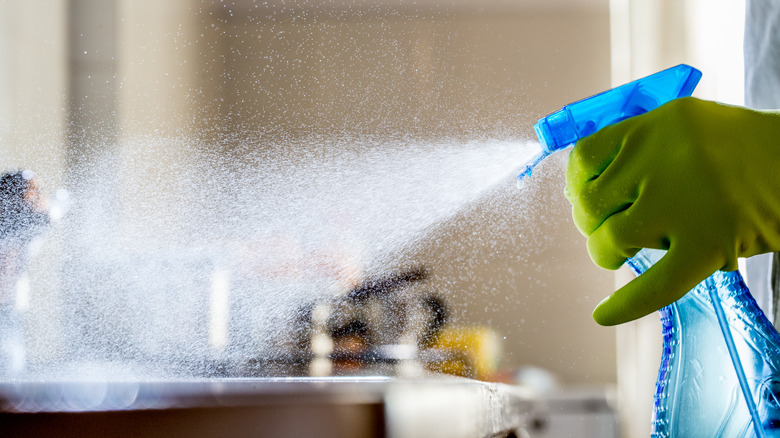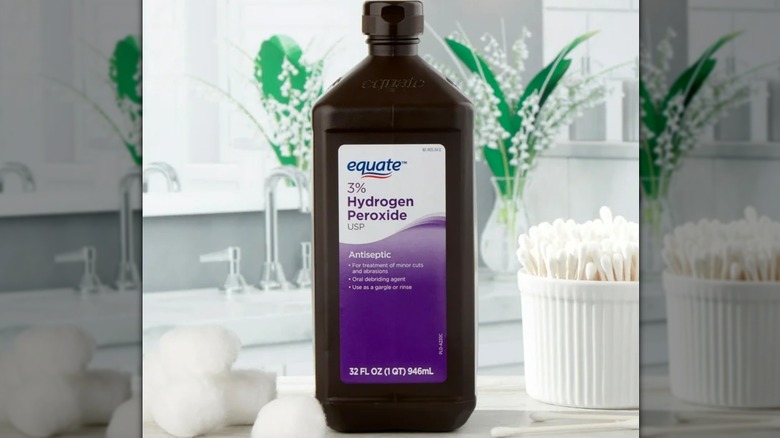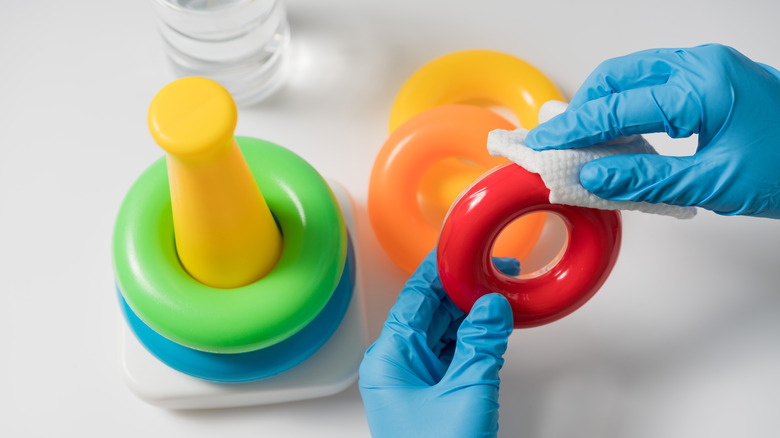Hydrogen Peroxide Is All You Need To Disinfect These Germy Spots In Your Home
Well-known for being an effective hair bleaching agent and teeth whitener, as well as for its previous use as an antiseptic, hydrogen peroxide is also a powerful disinfectant with remarkable properties. When formulated properly, you can even use hydrogen peroxide in your garden, as it can eliminate soil fungi or mold and spores in the soil. Given its potent disinfectant capabilities, it's no wonder that hydrogen peroxide is gradually gaining popularity for its use in cleaning and sanitizing high-traffic areas or germy spots in homes. These include doorknobs, light switches, remote controls, refrigerator and faucet handles, toilet flush handles, and toys.
Various items in the home that are frequently touched by multiple household members throughout the day are hotspots for the transmission of all sorts of microorganisms, including pathogens. Disinfecting these high-touch areas offers numerous benefits for both health and hygiene. For instance, with regular cleaning and disinfection, you can significantly reduce the risk of spreading illnesses such as colds, the flu, and stomach bugs among family members. This is particularly important for protecting vulnerable individuals such as young children, the elderly, or those with weakened immune systems. By using hydrogen peroxide to disinfect these germy areas, you're making a safe and environmentally-friendly choice.
The science behind the disinfecting power of H2O2
The effectiveness of hydrogen peroxide as a disinfectant for these high-touch areas is backed by science. Chemically represented as H2O2, hydrogen peroxide is essentially water with an extra oxygen molecule that makes it highly reactive. The reactivity of hydrogen peroxide is particularly evident in its ability to oxidize organic compounds and microorganisms such as bacteria, viruses, and fungi. When hydrogen peroxide comes into contact with these microorganisms on your light switches, doorknobs, and other germy areas, it readily reacts, breaking down into water and oxygen while effectively killing the pathogens.
However, it's essential to note that while hydrogen peroxide is a powerful disinfectant, it's also unstable and can degrade over time and with exposure to heat and light. It may also not be as effective against bacterial spores at low concentrations (i.e., less than 2%). Medical-grade H2O2 at 3% strength works best for general home use. If you want to purchase this cleaner, 3% H2O2 by Quality Choice retails for about $9 at Walmart for a 16-fluid-ounce bottle. At Walgreens, you can get an 8-fluid ounce 3% hydrogen peroxide spray for less than $4. To kill germs effectively, hydrogen peroxide solution on a surface should ideally have a minimum contact time of 10 minutes.
How to disinfect with hydrogen peroxide
There are many ways to use hydrogen peroxide in the home as a disinfectant, since it boasts an effectiveness comparable to bleach, minus the toxicity. To effectively disinfect using hydrogen peroxide, clean each item thoroughly to remove any visible dirt or grime, then allow it to air dry. This step is vital because dirt or organic matter can reduce the effectiveness of hydrogen peroxide.
Then, wipe remote controls, light switches, and other electronic items with a damp cloth soaked in hydrogen peroxide solution. For non-electronic items like handles and doorknobs, apply hydrogen peroxide using a spray bottle, ensuring complete coverage. Let the liquid sit for 10 minutes, then wipe it with a clean cloth or allow it to air dry. To disinfect plastic, rubber, and foam toys, soak them in warm water to loosen dirt and grime, then wipe dry. Mix equal parts H2O2 and water in a spray bottle, then apply the solution all over each toy, leaving it on for 10 minutes. Using a microfiber cloth, wipe each toy dry or leave it to air dry.
You can also minimize the unintentional spread of germs in your home by encouraging frequent handwashing. Gather all the things in your house you should be cleaning daily and use hydrogen peroxide as your post-cleaning disinfectant. Wear gloves and always work in an area with ventilation when cleaning with hydrogen peroxide, as it can burn the skin and eyes, especially at high concentrations.


